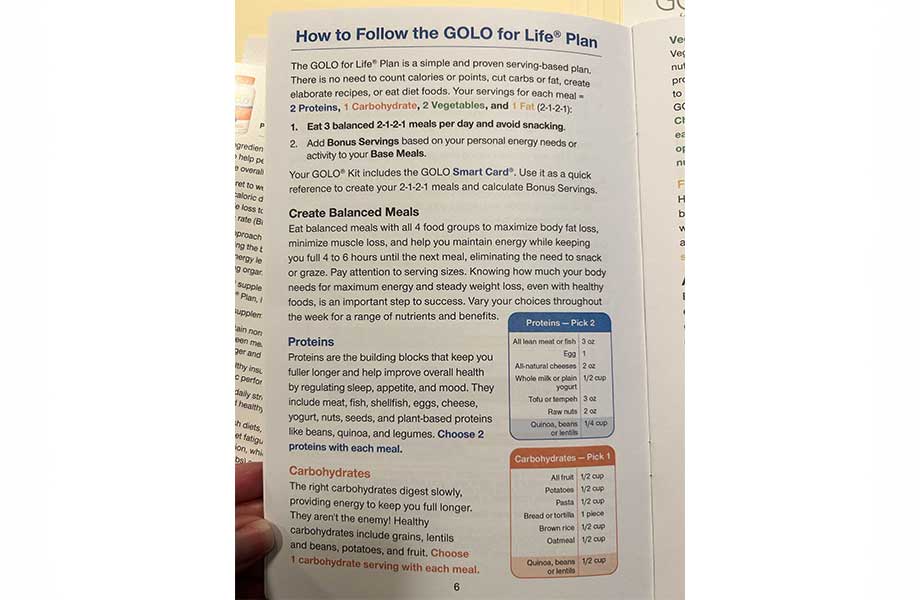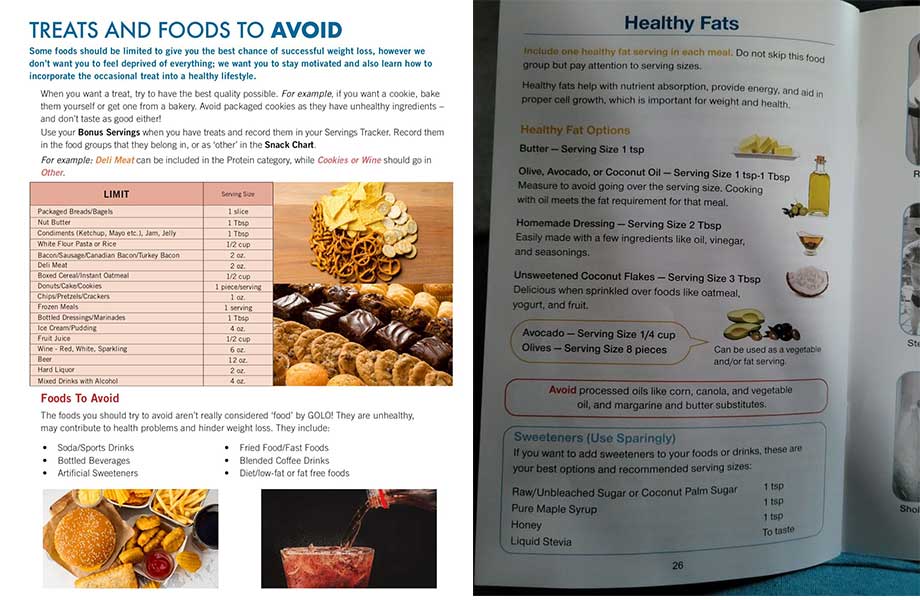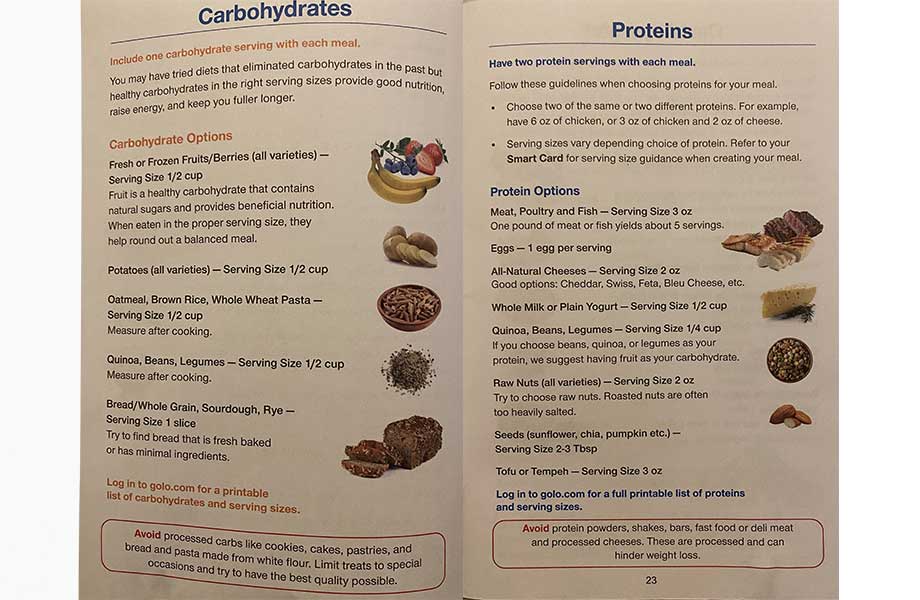We test and review fitness products based on an independent, multi-point methodology. If you use our links to purchase something, we may earn a commission. Read our disclosures.
Want to know the secret to lasting weight loss and wellness? According to GOLO—which stands for “GO LOse weight, GO LOok great, GO LOve life”—it’s all about controlling glucose, maintaining healthy insulin levels, and ditching conventional starvation diets.
Appealing, right? As a registered dietitian nutritionist (RDN), I can easily spot gimmicky, weird diets among evidence-based principles. While I support some of GOLO’s concepts and appreciate their catchy wordplay, I remain cautious about many of their recommendations—and think you ought to know about them.
If you’re curious about how the GOLO Diet works and if it’s worth your time and dollars, join me in this GOLO review. I’ll objectively lay out the GOLO program’s pros and cons so you can make an informed decision. Let’s GOLO right into it!
Medical disclaimer: This article is intended for educational and informational purposes only. It is not intended as a substitute for medical advice. For health advice, contact a licensed healthcare provider.
What Is the GOLO Diet?
GOLO is a weight loss program that combines diet and regular exercise with Release, its flagship dietary supplement. GOLO suggests that by taking one Release capsule with each prescribed meal, you can “fix your weight problem from the inside out” by targeting insulin resistance.
Before we discuss the GOLO Diet, let’s briefly discuss insulin resistance. Insulin resistance1 occurs when the body’s cells don’t respond well to insulin, the hormone that regulates blood sugar levels. As a result, the body produces more insulin, leading to higher hormone levels, which can worsen insulin resistance, increase the risk of Type 2 diabetes, and hinder your ability to maintain a healthy weight2.

Now that we better understand insulin resistance, let’s explore the specifics of the GOLO Diet plan.
Foods to Eat
The GOLO Diet centers around its “Metabolic Fuel Matrix,” a point-based system that lets you choose from four essential “fuel groups”—proteins, carbs, vegetables, and fats. Examples of foods from each group include:
- Proteins: Meat, fish, shellfish, nuts, seeds, and plant-based proteins (like quinoa or beans and other legumes)
- Carbohydrates: Grains, lentils, beans, potatoes, and fruit (especially berries)
- Vegetables: Primarily non-starchy veggies, like asparagus, broccoli, cucumbers, and leafy greens; avocado and olives are also included in the vegetable group but may be allocated as a fat serving
- Fat: Butter, olive oil, coconut oil, avocado oil, and unsweetened coconut flakes
GOLO recommends consuming 1,300 to 1,800 calories and three balanced meals daily, following their “2-1-2-1” guideline: 2 servings of protein, 1 serving of carbohydrates, 2 servings of vegetables, and 1 serving of fat per meal. You may also earn “bonus servings” of either carbohydrates or proteins based on your daily activity levels and if you engage in structured exercise for more than 30 minutes.
RELATED: High-Protein Low-Fat Foods
Foods to Avoid
For successful weight loss, GOLO recommends limiting or avoiding certain foods. They provide a list divided between foods to limit and those to ideally avoid.

Limit:
GOLO suggests that you don’t need to feel deprived, so they offer a list of foods to enjoy occasionally. These foods, while mostly off-limits, may be included in moderation:
- Condiments like ketchup and mayo
- Packaged breads and bagels
- White flour pasta and rice
- Sugary sweets like donuts, cake, and ice cream
- Processed meats such as bacon, sausage, and deli meats
- Alcohol
Avoid:
GOLO recommends steering clear of the following “foods” (that they don’t consider real food), as they can contribute to health issues and impede weight loss:
- Soda and sports drinks
- Bottled beverages
- Artificial sweeteners
- Fried food
- Fast foods
- Blended coffee drinks
- Protein powders, shakes, and bars*
*While protein supplements are not directly listed on the “Treats and Foods to Avoid” list, they are mentioned on GOLO’s protein information sheet. I respectfully disagree with their stance, particularly given the proven benefits of the best protein powders for weight loss.
What Is the GOLO Release Supplement?
The GOLO Release supplement is a blend of plant-based ingredients and minerals, including:
- Magnesium
- Zinc
- Chromium
- Rhodiola extract
- Inositol
- Berberine extract
- Gardenia extract
- Banaba extract
- Salacia extract
- Apple extract
The GOLO website claims that their proprietary formula, delivered at a clinically-studied dosage, is proven to help reduce insulin resistance and stubborn belly fat. Additionally, GOLO asserts that Release may improve metabolic health, reduce stress and anxiety, combat cravings, increase energy, support immunity, and more.
Research shows that plant-based compounds in Release, like berberine3 and Banaba4, aid diabetes and weight management. Its minerals—magnesium, zinc, and chromium—regulate glucose and energy metabolism, and a 2020 review5 notes deficiencies in these minerals can cause insulin resistance or diabetes.

Sounds promising, right? In theory, absolutely. However, the reality is that the plant compounds are part of a proprietary blend, meaning there’s no way to know the exact amounts of each ingredient.
Let’s break this down further:
Each Release capsule contains 297 milligrams, the recommended dose per meal. While berberine shows potential for improving blood glucose levels, 20213 and 2022 meta-analyses6 indicate that effective doses exceed 1 gram daily. Even if tripling the Release dose to cover three meals a day, less than 900 milligrams falls short of the effective dose needed for the combined 10 ingredients. Think of this as getting 1 gram of creatine from a pre-workout supplement, although an effective creatine monohydrate dosage is 3 to 5 grams daily.
Considering the mineral content, taking the recommended three Release capsules daily provides 45 milligrams of magnesium (12% DV), 30 milligrams of zinc (273% DV), and 210 micrograms (600% DV) of chromium. The magnesium7 content is relatively low, while its 30 milligrams of zinc8 is near the recommended upper limit of 40 milligrams daily. Plus, lower doses of zinc (less than 25 milligrams daily) over longer durations appear to offer more favorable benefits on blood glucose and other health metrics than higher doses. Chromium appears incredibly overdosed, but at least 200 micrograms of supplemental chromium9 can improve glucose and insulin levels, which Release offers, and some individuals may require a higher dose.
RELATED: Best Magnesium Supplements
Beyond the proprietary blend’s likely ineffectiveness, dietary supplements aren’t tightly regulated by the Food and Drug Administration (FDA). GOLO claims they perform extensive third-party finished product testing on every lot produced, but there’s no indication of which independent agency conducts these tests.
Always consult a healthcare professional before starting any new supplement regimen, especially if you manage diabetes or are taking prescription medications.
Scientific Research on the GOLO Diet
The GOLO website cites studies affirming the safety and effectiveness of their Release supplement and diet for weight loss and improving insulin resistance. These studies also suggest improvements in health metrics such as blood pressure and cholesterol levels.
However, it’s important to note that while these studies show favorable outcomes for the GOLO program, GOLO funded them and involved very small sample sizes. For example, a pilot study10 had only 16 participants, while a randomized, double-blind, placebo-controlled study11 included just 34 subjects. The studies also report a high dropout rate, indicating difficulty in adhering to the program. Additionally, three subjects dropped out due to gastrointestinal side effects.
The researchers emphasize that the ingredients in Release could boost the effectiveness of the GOLO Diet. Although Release is marketed as safe for long-term use, typically with most people taking it for three to six months per GOLO, there’s no substantial evidence to support its long-term safety or efficacy, as the studies conducted only assessed Release over a short-term span of 13 weeks.
GOLO Diet Pricing
The GOLO Diet offers various purchasing options for Release, its flagship weight loss supplement. Each bottle of Release contains 90 vegetarian capsules, designed to last 30 to 45 days, depending on individual usage.
Here’s a breakdown of the pricing:*
- 1 bottle of Release: $59.95 for 90 capsules, about $2.00 per day
- 2 bottles of Release: $99.90 (save $20) for 180 capsules, roughly $1.67 per day
- 3 bottles of Release: $119.85 (save $60) for 270 capsules, roughly $1.33 per day
*The daily cost is based on the recommended intake of 3 capsules per day with meals.
Each purchase of the Release supplement comes with two complimentary services: 1) the “GOLO for Life Plan,” valued at $50, which is essentially their diet program, and 2) “myGOLO,” valued at $199, an account portal that offers access to a wealth of online resources, tools, and support such as meal plans and recipes.
Pros of GOLO
As a dietitian, I recognize the advantages of the GOLO Diet, both from evidence and my professional experience. Here are the key points that I believe could make GOLO effective:
Encourages Slow, Steady Weight Loss
GOLO promotes a healthy and sustainable weight loss of 1 to 2 pounds per week, with this pace supported for long-term maintenance. Even a modest 5% weight loss can significantly improve health, reducing risks for cardiovascular disease, diabetes, and liver and kidney impairments2.
Promotes Balanced Nutrition
Unlike some diets that cut out food groups (looking at you, keto diet), GOLO promotes a whole-food, balanced diet with all three macronutrients: carbohydrates, fats, and proteins. This approach helps ensure you receive essential nutrients while helping you manage weight and blood sugar levels. For instance, the fiber in whole grains regulates blood sugar and promotes satiety, while lean proteins help slow down carb digestion and prevent rapid blood sugar spikes.
Encourages Healthy Lifestyle Changes
Managing insulin resistance involves lifestyle changes such as reducing calorie intake, limiting foods that cause insulin spikes, and exercising regularly1. GOLO offers a diet plan and encourages exercising for at least 15 minutes daily.
Offers Resources and Community
GOLO offers a range of resources and a supportive community to assist customers in their weight loss journeys. These include various challenges (like a virtual 5K), a members-only Facebook group, and recipes to provide guidance, motivation, and accountability.
Cons of GOLO
Although GOLO has its positives, several red flags need consideration and reveal why it didn’t make the cut as one of the best weight loss programs. Drawbacks of the GOLO program include:
Potential Safety and Effectiveness Issues
GOLO’s main drawback (IMO) is the company’s promotion of and the consumer’s reliance on its dietary supplement for revenue. While they claim Release is safe and formulated in clinically-effective doses, the proprietary blend lacks transparency on dosing and third-party testing. Additionally, the program lacks peer-reviewed research, and existing studies are funded by GOLO, raising concerns about the reliability of their safety and effectiveness claims.
High Costs
While the diet plan can be budget-friendly, the supplements can be costly. GOLO recommends taking them for three to six months, with a three-month supply costing a minimum of $120 and a six-month supply around $240. This bundle option is the most cost-effective, as purchasing single bottles or smaller quantities will increase the price.
Potentially Restrictive Guidelines
While some might appreciate the straightforward roles of the GOLO for Life Plan, others may find it overly restrictive due to its specific guidelines on calories, foods, and portions. Despite GOLO’s claim that their method isn’t a points system, the “pick 2 proteins, 1 carb, 2 veggies, 1 fat” approach can feel quite similar.
May Cause Confusion
As a dietitian, I can easily recognize that “Metabolic Fuel Matrix” is intriguing marketing jargon for what is simply a balance of macros. However, for the layperson, this term might spark confusion, adding to the already overwhelming amount of misinformation out there.
Furthermore, promoting a supplement for weight loss implies that GOLO works, which is what they want you to believe. If there were such a groundbreaking weight loss supplement, the world would know about it by now.
GOLO Review: Final Thoughts
The GOLO program combines a balanced diet, exercise guidelines, and its Release supplement to target insulin resistance and support weight loss. However, purchasing the Release supplement is a prerequisite to accessing the “free” eating plan and supporting resources.
While the program may help you manage weight, regulate hormones, and improve overall health, it can be expensive and challenging to adhere to. A significant concern is the lack of transparency regarding the proprietary blend in Release, which GOLO claims is safe and clinically effective but doesn’t back up with third-party testing information.
GOLO Review: FAQs
What is the downside of the GOLO diet?
The GOLO Diet involves purchasing a costly weight-loss supplement and following a potentially difficult diet plan. Limited research also makes it uncertain whether the supplement offers additional benefits over tried-and-true diet and exercise methods alone.
Has anyone lost weight with GOLO?
Based on studies funded by GOLO10,11 and various customer reviews, users have experienced and reported weight loss while on the GOLO program.
Does GOLO really reduce belly fat?
While GOLO claims its supplement can help reduce belly fat, spot reduction has yet to be proven. The most effective way to lose belly fat is by reducing overall body fat and incorporating resistance training to tone desired areas. Understanding macros for fat loss and muscle gain can help you achieve this goal.
How long does it take to see results with GOLO?
While individual experiences may vary, GOLO suggests most people begin to see noticeable benefits within the first 2 to 4 weeks.
These statements have not been evaluated by the Food and Drug Administration. This product is not intended to diagnose, treat, cure, or prevent any diseases.
References
- Freeman, A. M., Acevedo, L. A., & Pennings, N. (2023). Insulin Resistance. In StatPearls. StatPearls Publishing. https://pubmed.ncbi.nlm.nih.gov/29939616/
- Farhana, A., & Rehman, A. (2023, July 10). Metabolic Consequences of Weight Reduction. In StatPearls [Internet]. Treasure Island (FL): StatPearls Publishing; 2024 Jan-. Available from: https://www.ncbi.nlm.nih.gov/books/NBK572145/
- Guo, J., Chen, H., Zhang, X., Lou, W., Zhang, P., Qiu, Y., Zhang, C., Wang, Y., & Liu, W. J. (2021). The Effect of Berberine on Metabolic Profiles in Type 2 Diabetic Patients: A Systematic Review and Meta-Analysis of Randomized Controlled Trials. Oxidative Medicine and Cellular Longevity, 2074610. https://doi.org/10.1155/2021/2074610
- López-Murillo, L. D., González-Ortiz, M., Martínez-Abundis, E., Cortez-Navarrete, M., & Pérez-Rubio, K. G. (2022). Effect of Banaba (Lagerstroemia speciosa) on Metabolic Syndrome, Insulin Sensitivity, and Insulin Secretion. Journal of Medicinal Food, 25(2), 177–182. https://doi.org/10.1089/jmf.2021.0039
- Dubey, P., Thakur, V., & Chattopadhyay, M. (2020). Role of Minerals and Trace Elements in Diabetes and Insulin Resistance. Nutrients, 12(6), 1864. https://doi.org/10.3390/nu12061864
- Zamani, M., Zarei, M., Nikbaf-Shandiz, M., Hosseini, S., Shiraseb, F., & Asbaghi, O. (2022 October, 13). The effects of berberine supplementation on cardiovascular risk factors in adults: A systematic review and dose-response meta-analysis. Frontiers in Nutrition, 9, 1013055. https://doi.org/10.3389/fnut.2022.1013055
- National Institutes of Health. (2022, June 2). Magnesium – Fact Sheet for Health Professionals. https://ods.od.nih.gov/factsheets/magnesium-HealthProfessional/
- National Institutes of Health. (2022, September 28). Zinc – Fact Sheet for Health Professionals. https://ods.od.nih.gov/factsheets/zinc-HealthProfessional/
- National Institutes of Health. (2022, June 2). Chromium – Fact Sheet for Health Professionals. https://ods.od.nih.gov/factsheets/Chromium-HealthProfessional/
- Buynak R.J. (2019). Pilot study on the Effects of the GOLO Weight Management Program and RELEASE Supplement on Weight and Glycemic Control in Patients with Type 2 Diabetes Mellitus and Obesity. Diabetes Updates, 5(3). doi:https://doi.org/10.15761/du.1000125
- Buynak, R. J. (2019). A randomized, double-blind, placebo-controlled study evaluating the effects of the GOLO weight management program with and without Release supplement on weight and metabolic parameters in subjects with obesity. Trends in Diabetes and Metabolism, 2(1). https://doi.org/10.15761/tdm.1000109
Further reading

This guide shows you how to become an athletic trainer, covering requirements for education, clinical hours, and post-graduate opportunities. Read more

Trying to find the best iFIT workouts? We’re here to help with our top picks, no matter what your fitness level or preferred type of training program looks like. Read more

Are you looking to go deeper on your squats while working with ankle mobility issues? The heel-elevated goblet squat may be just the thing for you. Read more

Looking to save money on your next custom supplement order? Our True Nutrition Coupon Code will help you save money on your next order. Read more

